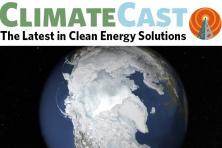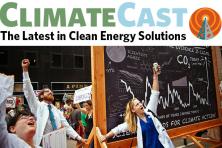Revelations and reflections: a New Year’s resolution for the climate
2017 was a year of numerous environmental setbacks at the federal level, while a punishing series of “natural” disasters highlighted the urgent need to act on climate. Climate change rose in the public consciousness due in part to these disasters—hurricanes, wildfires and floods so big that some could even be seen from space. Climate-themed photos of the year showcased the good as well as the bad, from promising innovations in clean energy, to places permanently changed due to record-breaking storms and wildfires. 2017 was also a year of fertile resistance, and there is good reason to expect 2018 will be a year of resolve for implementing solutions.
Hope
Some of your holiday dinners may have had an awkward moment when Uncle Walter chimed in on climate change asking “But what about China? They’re the real problem.” Now you can tell him that China is methodically building the world’s largest carbon market as part of an effort to meet ambitious climate and clean energy targets. China’s drop-off in coal use is just one reason that global coal consumption is now forecast to slow. Even fossil fuel giant BP is investing big in solar. The Netherlands is looking to build the world’s first subsidy-free offshore wind farm signaling that renewables are becoming so successful, they may not require a financial boost to get off the ground. Wind energy is already so successful in Texas that it recently surpassed coal as a top energy source for the state. Even the fossil fuel-friendly GOP congressional leadership recognizes the vast potential of renewables, preserving critical renewable energy tax credits in the tax plan passed into law last month.
In Hot Water
Sea level rise is already impacting America’s coastal cities, and the threat is projected to only get worse. In many cases, State and local governments are not prepared to handle the costs associated with protecting coastal cities. Two million people living near 327 superfund sites prone to flooding may be at particular risk. One California city surrounded on three sides by water is already experiencing extensive coastal flooding. In the Indonesian capital of Jakarta, climate-caused sea level rise is exacerbating another problem—the city itself is sinking, thanks to illegal wells draining underground aquifers and other failures of public planning. Some public officials are clashing with property owners when it comes to finding solutions to protect from sea level rise. Currently lucrative waterfront property may lose its value to higher elevated neighborhoods. As polar ice disappears at an alarming rate, new research shows that climate change is happening more quickly than once projected—and impacts like sea level rise will be more extreme than once projected.
Signs of climate chaos
New research concludes that extreme storms, temperatures, wildfire and other impacts are evidence of an altogether “new climate”—one we created through human activity. Climate impacts do not unfold equally or evenly, as recent news highlights. US athletes training for the winter Olympics are traveling further from home to find snow. In Alaska, climate change is triggering major increases in annual snowfall. And on the New England coast, a mass of Arctic air has created such brutally cold conditions that several sharks have washed ashore, unable to survive the cold conditions.
Setbacks that begin with “T.”
The Trump administration has dropped climate change from its official list of global security threats. Meanwhile, the Government Accountability Office also reports that the US military is not doing enough to prepare military bases for the threats posed by climate change. The administration’s mining regulators are also considering removing current rules that protect miners from the conditions known to cause black lung. Despite administration rhetoric about protecting coal industry workers and jobs, public data shows that coal mining deaths doubled from 2016 to 2017. The Trump administration also rescinded proposed rules that would have forced oil drilling companies to disclose which chemicals they use.
In Brief: politics aside, renewables work
The deepest-red areas of Texas are responsible for supplying 12 percent of the state’s energy needs—and they’re doing it with wind. Texas wind projects have, at times, even provided more than half the electricity needed to power the state’s entire grid. Never mind partisan politics, all Texans are experiencing just how well renewables work. Many understand that there’s no reason why supporting low-cost, clean, locally produced energy (and the local jobs created as a result of them) should be a partisan issue.





